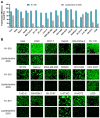Efficient mRNA Delivery In Vitro and In Vivo Using a Polycharged Biodegradable Nanomaterial
- PMID: 39769382
- PMCID: PMC11728123
- DOI: 10.3390/ijms252413620
Efficient mRNA Delivery In Vitro and In Vivo Using a Polycharged Biodegradable Nanomaterial
Abstract
As RNA rises as one of the most significant modalities for clinical applications and life science research, efficient tools for delivering and integrating RNA molecules into biological systems become essential. Herein, we report a formulation using a polycharged biodegradable nano-carrier, N1-501, which demonstrates superior efficiency and versatility in mRNA encapsulation and delivery in both cell and animal models. N1-501 is a polymeric material designed to function through a facile one-step formulation process suitable for various research settings. Its capability for mRNA transfection is investigated across a wide range of mRNA doses and in different biological models, including 18 tested cell lines and mouse models. This study also comprehensively analyzes N1-501's application for mRNA transfection by examining factors such as buffer composition and pH, incubation condition, and media type. Additionally, N1-501's superior in vivo mRNA transfection capability ensures its potential as an efficient and consistent tool for advancing mRNA-based therapies and genetic research.
Keywords: RNA research; RNA therapeutics; RNA translation; gene delivery; gene editing; mRNA transfection; protein translation; targeted delivery.
Conflict of interest statement
All Authors are employees of or advisors to N1 Life, Inc. The remaining authors declare that the research was conducted in the absence of any commercial or financial relationships that could be construed as a potential conflict of interest.
Figures







Similar articles
-
Tetrahydropyrimidine Ionizable Lipids for Efficient mRNA Delivery.ACS Nano. 2024 Oct 22;18(42):29045-29058. doi: 10.1021/acsnano.4c10154. Epub 2024 Oct 11. ACS Nano. 2024. PMID: 39393001 Free PMC article.
-
A Polymeric Nanoparticle Formulation for Targeted mRNA Delivery to Fibroblasts.Adv Sci (Weinh). 2023 Feb;10(5):e2205475. doi: 10.1002/advs.202205475. Epub 2022 Dec 18. Adv Sci (Weinh). 2023. PMID: 36529964 Free PMC article.
-
Quantitating Endosomal Escape of a Library of Polymers for mRNA Delivery.Nano Lett. 2020 Feb 12;20(2):1117-1123. doi: 10.1021/acs.nanolett.9b04426. Epub 2020 Jan 31. Nano Lett. 2020. PMID: 32003222 Free PMC article.
-
Nanotechnologies in delivery of mRNA therapeutics using nonviral vector-based delivery systems.Gene Ther. 2017 Mar;24(3):133-143. doi: 10.1038/gt.2017.5. Epub 2017 Jan 17. Gene Ther. 2017. PMID: 28094775 Review.
-
Polymeric nano-carriers for on-demand delivery of genes via specific responses to stimuli.J Mater Chem B. 2020 Nov 4;8(42):9621-9641. doi: 10.1039/d0tb01675f. J Mater Chem B. 2020. PMID: 32955058 Review.
References
MeSH terms
Substances
LinkOut - more resources
Full Text Sources
Research Materials

